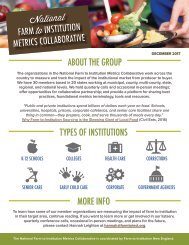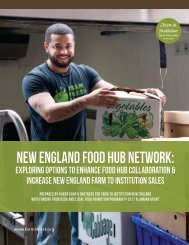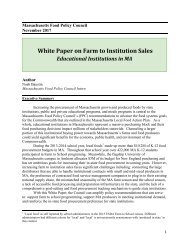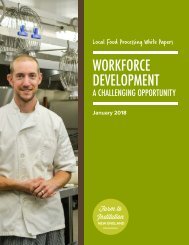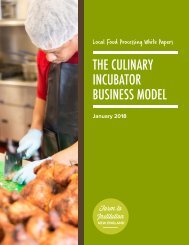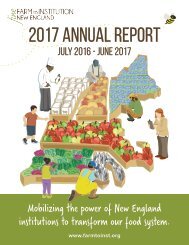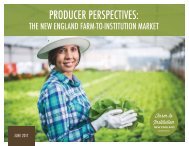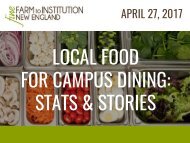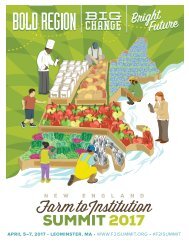Ntnl FTI Metrics Flyer
You also want an ePaper? Increase the reach of your titles
YUMPU automatically turns print PDFs into web optimized ePapers that Google loves.
Photo Credit: USDA<br />
HEALTH CARE WITHOUT HARM<br />
www.healthyfoodinhealthcare.org<br />
Mission: To transform the health sector worldwide,<br />
without compromising patient safety or care, so that<br />
it becomes ecologically sustainable and a leading<br />
advocate for environmental health and justice. Health<br />
Care Without Harm’s national Healthy Food in Health<br />
Care program harnesses the purchasing power and<br />
expertise of the health care sector to advance the<br />
development of a sustainable food system.<br />
<strong>Metrics</strong> Project Summary: To date, HCWH metrics have<br />
focused on traditional process indicators with a focus<br />
on local and sustainable foods as well as meats raised<br />
without the routine use of non-therapeutic antibiotics.<br />
This information has been collected through a national<br />
survey, implemented every other year. In addition to<br />
data collection with the health care sector, HCWH works<br />
with cross-sector partners at the regional and national<br />
levels to align our metrics with those being used in the<br />
college and K-12 sectors. To this end, the New England<br />
HFHC Team is a member of the FINE metrics advisory<br />
board. At the national level, we are working with Real<br />
Food Challenge and School Food Focus to align metrics.<br />
In 2016, we started developing a national strategy to<br />
consistently and reliably capture procurement data from<br />
the health care sector. We are doing so in coordination<br />
with our sister organization Practice Green Health. We<br />
also aim to develop impact indicators and a strategy for<br />
data collection in order to help demonstrate the impact<br />
of these shifting procurement patterns. What does it<br />
mean for farmer viability? For ecological health?<br />
For public health?<br />
JOHNS HOPKINS CENTER FOR A<br />
LIVABLE FUTURE<br />
http://mdfoodsystemmap.org<br />
www.jhsph.edu/research/centers-and-institutes/<br />
johns-hopkins-center-for-a-livable-future/index.html<br />
Mission: The Maryland Food System Map Project is<br />
a project of the Johns Hopkins Center for a Livable<br />
Future. The project provides space for users to look at<br />
different parts of the food system geographically and<br />
offers resources to help discover opportunities and<br />
inform activities aimed at strengthening the system. The<br />
project strives to unite food systems data from disparate<br />
sources; to develop and grow the body of food systems<br />
data in Maryland; and to support our partners in their<br />
work to create an equitable, environmentally sustainable<br />
and economically viable food system in Maryland.<br />
<strong>Metrics</strong> Project Summary: Institutions play an important<br />
role in the food system as large purchasers and servers<br />
of food to Maryland residents. In 2014, the project<br />
developed and disseminated surveys to universities and<br />
hospitals in Maryland to collect data on the economic<br />
impact of purchasing local foods by major institutions.<br />
We created two-page briefs describing the results and<br />
made datasets available to our users. In 2016, we are<br />
continuing this data collection and — since they are<br />
key players in the institutional food chain — we are<br />
adding food distributors to the mix. By collecting and<br />
growing the data available on Maryland institutional<br />
food purchasing, both overall and locally sourced foods,<br />
the project will provide a rich dataset and case studies<br />
useful to our partners in planning and advocating for<br />
farm-to-institution policy and growth.




